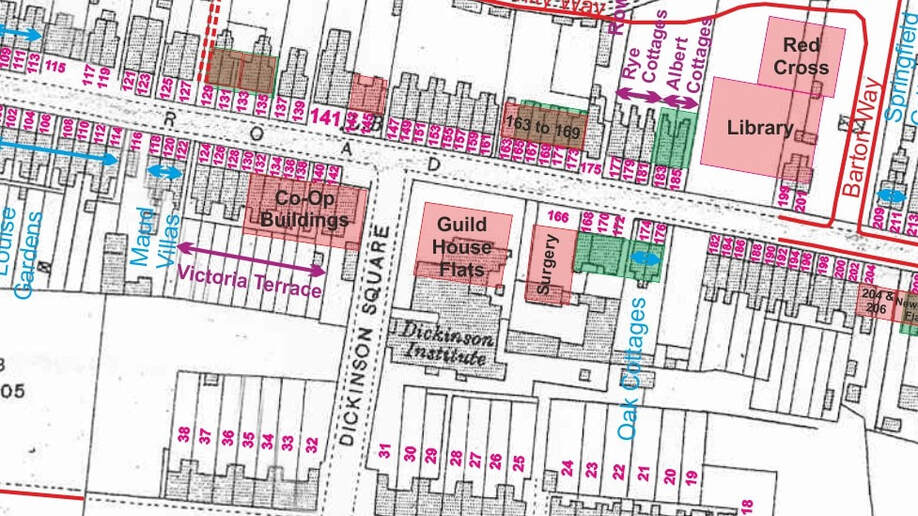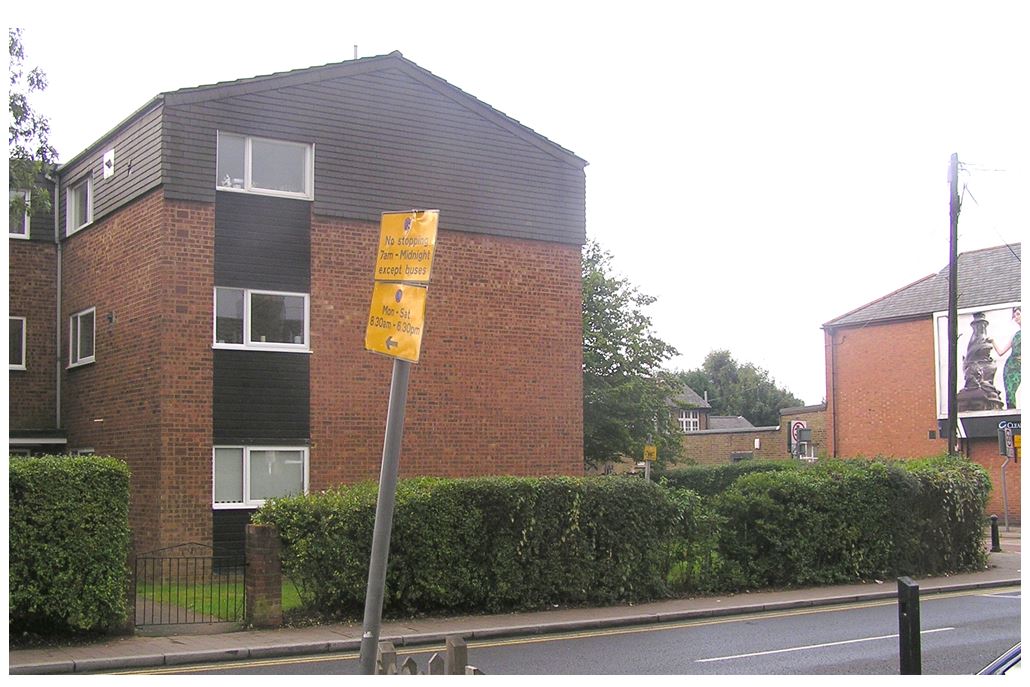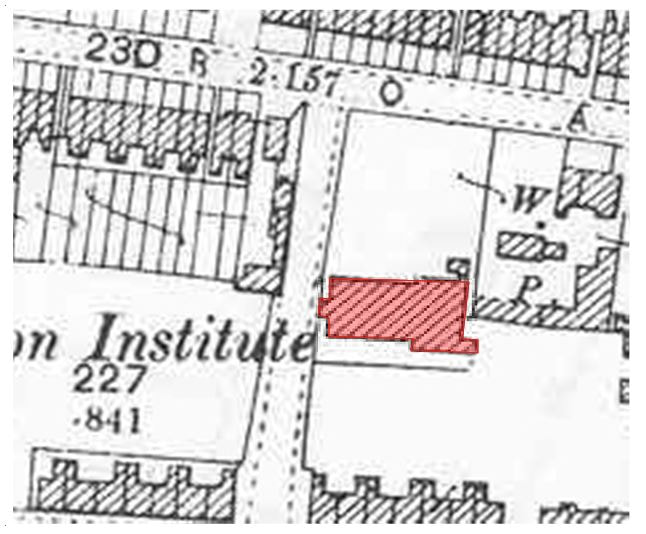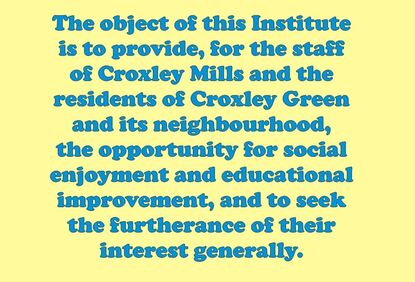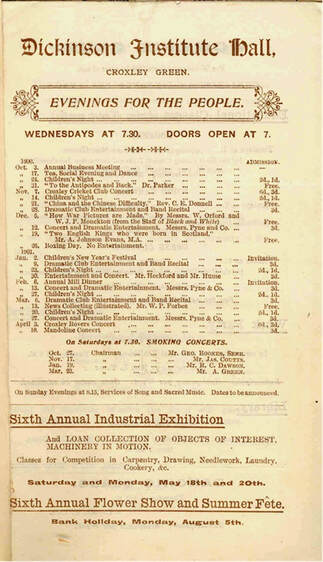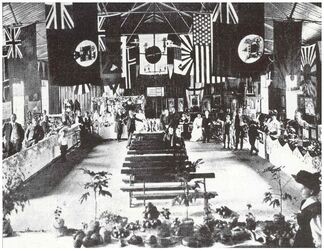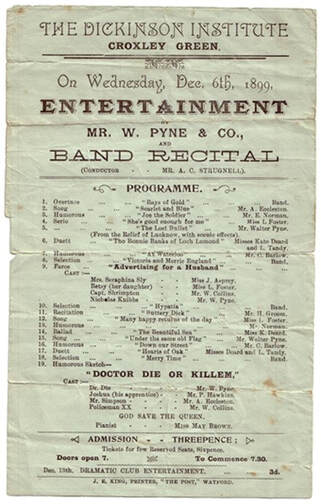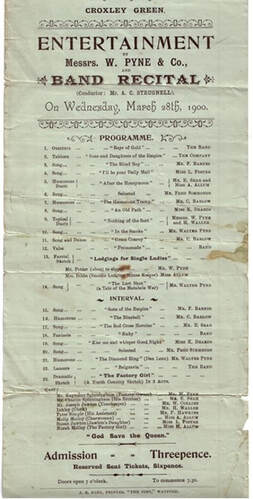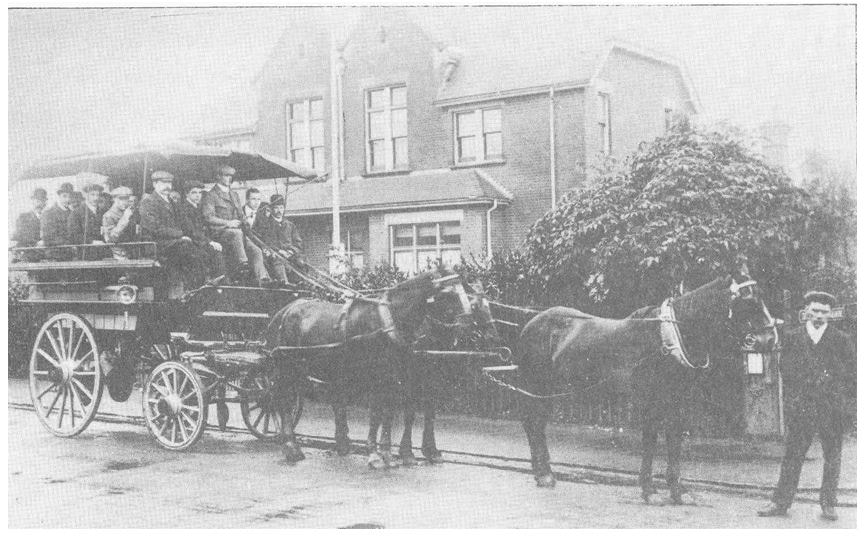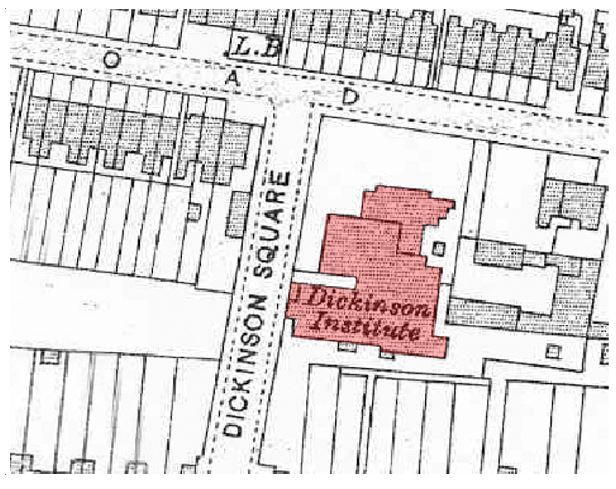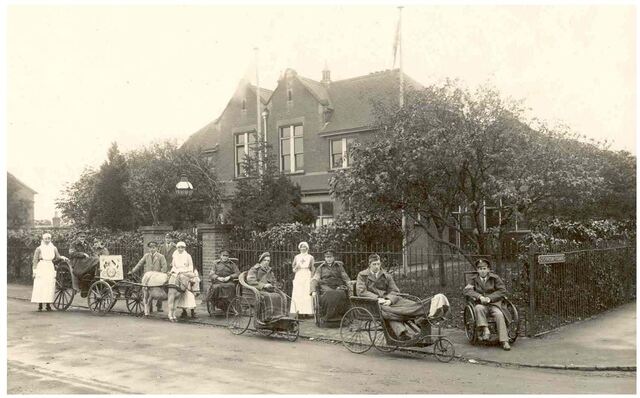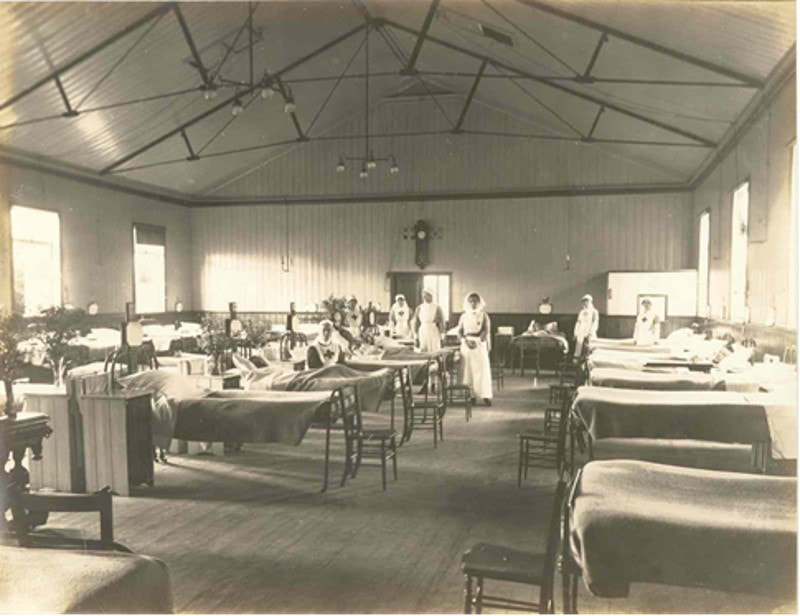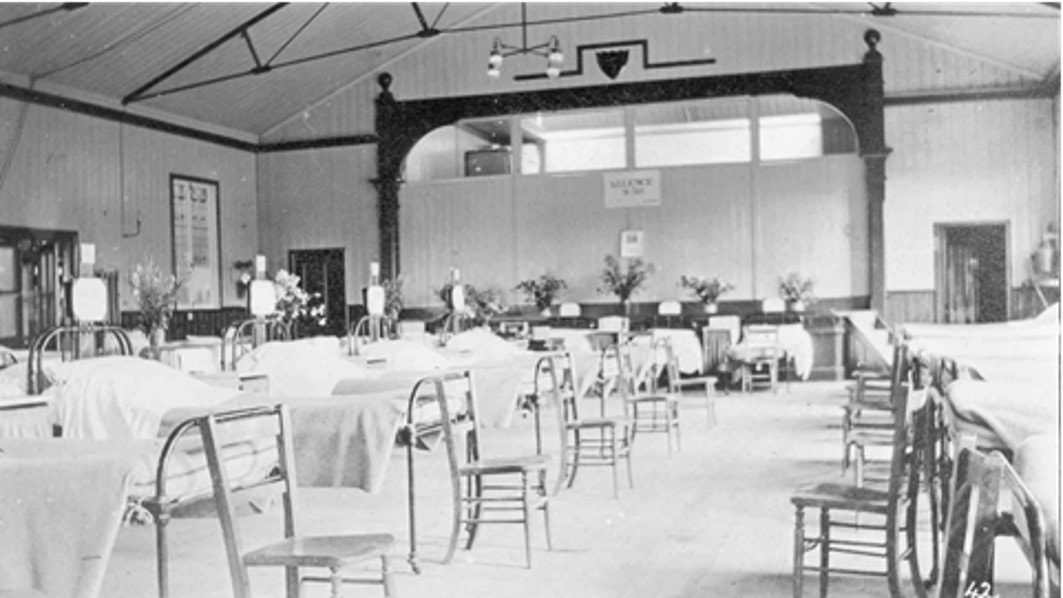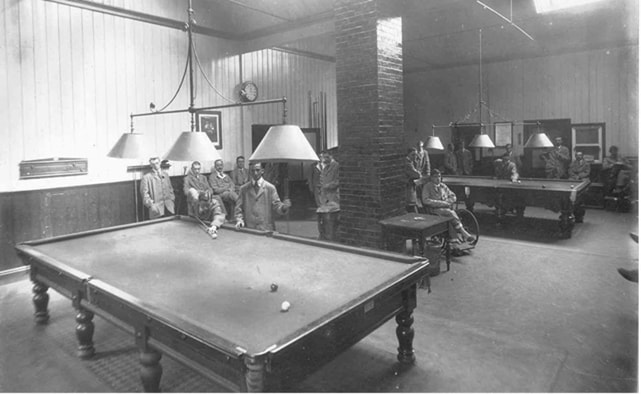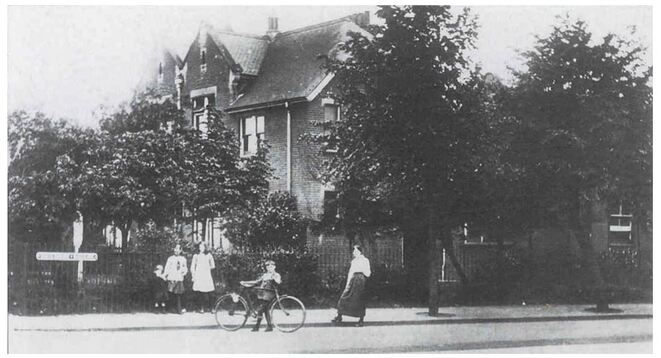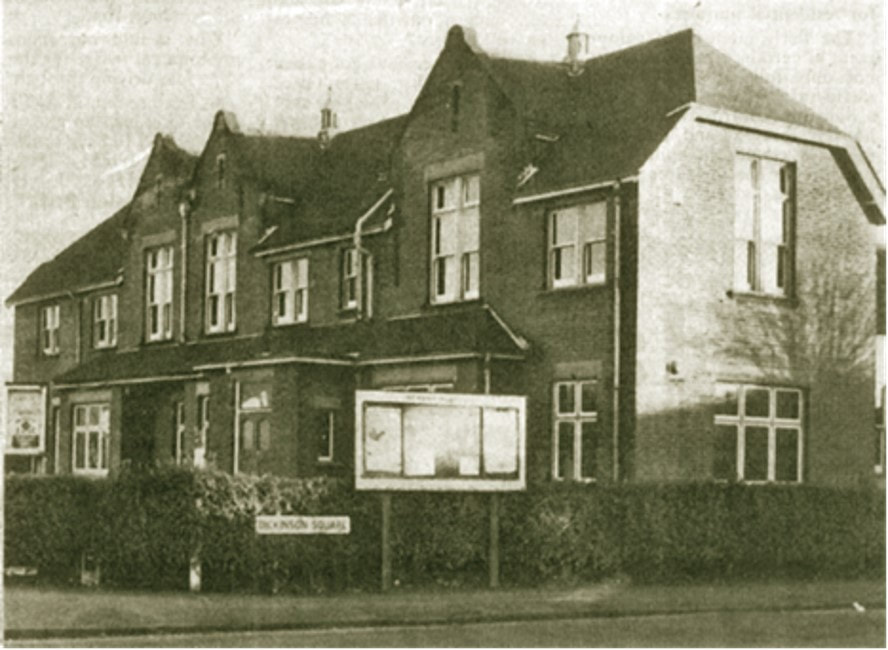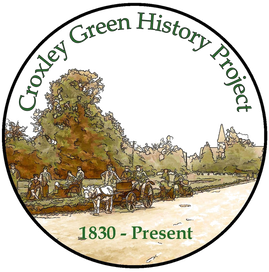A stroll down New Road - Evens The Institute
The first block of buildings encountered after Dickinson Square is the Guildhouse Flats, built in 1976 on the site previously occupied by the Dickinson Institute, later known as The Guildhouse. The Institute (or “The Tute” as it was often affectionately known) obviously had a major impact on the leisure and cultural life of the surrounding area.
It was in November 1895 that Charles Barton-Smith, manager of Croxley Mills from 1895 to 1918, having seen the need for a social club in the village, called a meeting of employees at the Mills, and the Dickinson Institute came into being.
At first one of the firm’s houses, No. 32, Milestone Field was used as the club room, the opening ceremony taking place on December 2nd 1895. Incidentally, this house later became 31 Dickinson Square as the former no. 13 was reinstated. Later generations must have been less superstitious! It was originally described as a “club and reading room”, but it was so successful that, to cope with the increasing membership, a second house in Dickinson Square was taken over.
Membership continued to increase and in the following year the Directors agreed to build a hall, with stage and three rooms surrounding it, for the Institute premises. This was opened on November 8th, 1896.
It was in November 1895 that Charles Barton-Smith, manager of Croxley Mills from 1895 to 1918, having seen the need for a social club in the village, called a meeting of employees at the Mills, and the Dickinson Institute came into being.
At first one of the firm’s houses, No. 32, Milestone Field was used as the club room, the opening ceremony taking place on December 2nd 1895. Incidentally, this house later became 31 Dickinson Square as the former no. 13 was reinstated. Later generations must have been less superstitious! It was originally described as a “club and reading room”, but it was so successful that, to cope with the increasing membership, a second house in Dickinson Square was taken over.
Membership continued to increase and in the following year the Directors agreed to build a hall, with stage and three rooms surrounding it, for the Institute premises. This was opened on November 8th, 1896.
|
From the outset, club membership was available both to employees of Messrs Dickinson's and also residents of Croxley Green, (though in early years these terms were almost synonymous), as it was considered that club members in their leisure hours would wish to meet others besides the people they worked with. The only difference was, I believe, that mill workers had a free membership as of right and free of charge, whereas other local residents had to apply for membership and pay a small annual fee.
A Statement of the board’s objectives is set out in the adjacent diagram. A library was started, to be succeeded many years later by a branch of the County Library. |
|
A youths' brigade was running in 1898, using the hall for drill and a clubroom for games and handcraft. In 1900 this became recognised as a Company of the Church Lads Brigade.
Technical classes were held, by arrangement with the County Council, and included cookery, carpentry, wood-carving and dress-making. These continued until, with the arrival of a bus service in Croxley, easier access to Watford and London made the local classes less popular. Probably, too, the wider range of subjects being taught at school was making adult classes less necessary. The committees promoted many social activities, concerts, lectures, dramatic shows and industrial exhibitions and every year a leaflet was produced giving details of the year’s proposed programme. An example of one page of the leaflet for the 1900/1901 season is displayed here. The main Wednesday Evening entertainments in the hall were described as “Evenings for the People” and the season seemed to run from October to April. I have to confess that I had never heard the term “Smoking Concert” so I looked it up on the internet and found that it was a bit like a genteel music hall where the men (mainly) could sit with their cups of tea or coffee, smoking their cigars or pipes and be entertained. |
For many years from its opening through the early 1900s the Dickinson Institute hosted the Annual Industrial Exhibition with exhibits from all over the country, some involving the transportation of some quite large pieces of machinery.
A programme for the 5th Annual Industrial Exhibition in 1900 indicated that it included demonstrations of:-
A programme for the 5th Annual Industrial Exhibition in 1900 indicated that it included demonstrations of:-
- Manufacture of Pottery by Messrs Stanley Bros of Nuneaton
- Glass Blowing by Messrs Cosser and Son of Clerkenwell Green
- Ornamental Ironwork by Messrs Starkie, Gardner and Co of Albert Embankment
- Lace Paper Manufacture by The Atlas Lace Paper Works of Wardour Street
- Printing by Mr W Kingham of Kings Langley
- Artificial Flower Making by Mr Herring of Almoragh Road, East London
- Dairy Farming by Mr C Sansom of Croxley Hall Farm
- Dairy Appliances by The Dairy Supply Association of Museum Street
- Chick Hatching by Incubator by Messrs Hearson and Co, Regent Street
- Mutoscopes and Biographs by The London Mutoscope Co, Rupert Street
- Automatic Photo Machine by The Automatic Photo Machine Syndicate of Bishopsgate
- Electric Appliances by The General Electric Company of Queen Victoria Street
- Galvanic Batteries by Messrs Drake and Gorham of Victoria Street
- Models of Ships etc. by The Marine Engineers Institute
- Automatic Weighing Machine by W & T Avery Ltd, Cowcross Street
- Mineral Waters by Springwell Ltd. of Rickmansworth
- Bicycles by Mr J Patterson of Scots Hill, Croxley
- Notepaper and Fancy Stationery by Croxley Mills
- Scientific Instruments used in the Classroom
|
The nearby picture was actually engraved, printed and sold at the 13th Annual Exhibition in 1908.
It is said that the first motor car to be seen in Croxley was displayed at one of these exhibitions. It is an interesting sign of the times that the exhibitions were open on Saturday and Monday but never on a Sunday! It is interesting to note the number of Dramatic Entertainments during the October to April season averages out at a little over one every four weeks. Anyone who has ever been involved with amateur dramatics will know what a massive undertaking this is. |
Here are a couple of examples of the Playbills from the Wednesday evening entertainments in 1899 and 1900.
An advert in the 1902 Peacock’s Directory set out in some detail the wide range of activities that were available to club members …………
Steadily the club and meeting rooms were being extended, and in 1904 a brick building facing New Road, said to include classrooms and baths, was opened. This marked the centenary of Dickinson’s.
Throughout this whole period there had also been dancing and gymnasium classes for girls, in several age groups, run by Miss Barton-Smith. She formed a company of Girl Guides in 1919 and these activities were continued as part of that organisation.
- Men's Club - reading room, smoking room, bagatelle room, coffee room, free library, billiards room, draughts club, educational and technical classes, gymnasium, lectures, debates, winter classes in paper making, wood carving, joinery and machine drawing, etc.
- Women's Club - reading room, educational classes, part singing, cookery, dress-cutting and making, dancing, free library, etc
- Other Activities - Youth's Brigade (later to become a Boys Brigade Company), Orchestral Band; Drum and Fife band, Entertainments and Dramatics, Cricket and Football teams, Cycle Club, Co-Operative Stores, Benefit Club, Girls Dancing and Gymnasium Class (later overtaken by the Girl Guide Company).
- Shows etc - “Evenings for the people” - concerts, slide shows, talks or events every Wednesday at 7.30; monthly Saturday Evening “Smoking Concerts”; “Annual Industrial Exhibition”, May Fruit and Flower Show and regular Lantern shows and Shadow entertainments for children, etc
Steadily the club and meeting rooms were being extended, and in 1904 a brick building facing New Road, said to include classrooms and baths, was opened. This marked the centenary of Dickinson’s.
Throughout this whole period there had also been dancing and gymnasium classes for girls, in several age groups, run by Miss Barton-Smith. She formed a company of Girl Guides in 1919 and these activities were continued as part of that organisation.
|
Until about 1905, when a more reliable bus service was introduced, the Institute was used as a picking up point by George Wilbee and his “Three Horse Brake”. For sixpence he would run passengers into Watford. Whether this included the return fare or they had to pay again I don’t known. This photograph is of Croxley Green men who would hire the brake for a day out to the pubs in Sarratt or Chipperfield.
|
|
There were a number of extensions to the original hall and rooms which included more small rooms and halls and a bath block. I suspect that a number of the cottages still did not have bathrooms by this time.
The adjacent extract from the 1914 O.S. map shows how the final building looked at that date. |
Between 1914 and 1919 the premises were closed to the general public and donated to the war effort for use as a Voluntary Aid Detachment (V.A.D.) convalescent hospital for soldiers injured in the course of the First World War.
The postcard above shows some of the convalescing soldiers in the bath chairs outside the Institute. There is even one driving a small pony and trap which, contemporary accounts say, was often seen driving around The Green!
The hospital eventually had 35 beds, mostly situated in what had been the main hall but with a few in a side room but even this did not go smoothly as this short extract from the December 1915 issue of the All Saints’ magazine explains ….
“The Hospital – There has been considerable delay in fitting up the Institute as a hospital owing to the delinquencies of the railway companies. The beds were dispatched some time ago but got hung up en route. But they have at last arrived and soon the hospital will be ready to receive 30 patients. The kitchen arrangements are not yet complete, but Mrs Kennedy thinks that everything will be in working order by the beginning of December. Things are a bit quiet on the French Front just at present, and the number of wounded being sent over must be comparatively small. It is possible, therefore, that the authorities may not require the accommodation for some time to come. The Quartermaster (Mistress?) will be glad of books and magazines for soldiers as soon as the hospital opens.”
The quartermaster (Mistress?) referred to was Maud Barton-Smith, daughter of Charles Barton-Smith, the Mill Manager.
The hospital eventually had 35 beds, mostly situated in what had been the main hall but with a few in a side room but even this did not go smoothly as this short extract from the December 1915 issue of the All Saints’ magazine explains ….
“The Hospital – There has been considerable delay in fitting up the Institute as a hospital owing to the delinquencies of the railway companies. The beds were dispatched some time ago but got hung up en route. But they have at last arrived and soon the hospital will be ready to receive 30 patients. The kitchen arrangements are not yet complete, but Mrs Kennedy thinks that everything will be in working order by the beginning of December. Things are a bit quiet on the French Front just at present, and the number of wounded being sent over must be comparatively small. It is possible, therefore, that the authorities may not require the accommodation for some time to come. The Quartermaster (Mistress?) will be glad of books and magazines for soldiers as soon as the hospital opens.”
The quartermaster (Mistress?) referred to was Maud Barton-Smith, daughter of Charles Barton-Smith, the Mill Manager.
|
The adjacent photo shows the main ward looking towards the rear exit of the hall. Whilst most of the patients were up and about it is possible just to make out two or three of them still in bed.
The hall had been painted white, having previously been a bit on the dark side, and it was said that this caused an “ethereal glow” in the room when the sun shone. Whether that is captured in the photo or they have just faded I’ll leave to your judgement. |
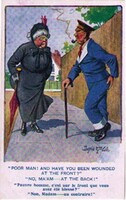
The last photo from the First World War period shows the inmates playing in the billiards room. (Snooker was only just beginning to grow in popularity at this time.)
The men are wearing the blue uniform that convalescing soldiers were required to wear in hospital and in public, which generally became known as “Convalescent Blues”. It was designed so that a handful of sizes would fit all recovering soldiers and inevitably it was a poor fit which required soldiers to turn up their trouser legs and shirt sleeves. The uniform also included a red tie.
It made the soldiers readily recognisable in public, as the nearby postcard comically shows, but also protected them from being harangued and spat on by the “white feather” brigade who might otherwise have mistaken them for conscientious objectors.
The men are wearing the blue uniform that convalescing soldiers were required to wear in hospital and in public, which generally became known as “Convalescent Blues”. It was designed so that a handful of sizes would fit all recovering soldiers and inevitably it was a poor fit which required soldiers to turn up their trouser legs and shirt sleeves. The uniform also included a red tie.
It made the soldiers readily recognisable in public, as the nearby postcard comically shows, but also protected them from being harangued and spat on by the “white feather” brigade who might otherwise have mistaken them for conscientious objectors.
After the General Strike of 1926, the managers of the John Dickinson Company proposed that the mill workers form their own Trades Union. The Charter drawn up named it the Union of the House of Dickinson, and it followed that in 1928 The Dickinson Institute was renamed The House of Dickinson Guild, Croxley Guildhouse.
Through the years a helpful and benevolent policy was maintained, which assisted and provided a home and meeting place for a large number of societies concerned with sport, music, dramatics, physical culture, and literature. In 1938 a Darts room and Committee room were added, and in October 1939 a new lounge and further club rooms were opened.
At lunchtime on Sunday 3rd October 1965 the hall attached to the Guildhouse was destroyed by fire and immediately closed, although the remainder of the building continued to be used regularly until, in the autumn of 1974, the upper floor was declared unsafe.
John Dickinson Company were no longer able to justify the expense of maintenance and repairs and, on the last Saturday in November 1974 a final “Night to Remember” was held with the remaining four hundred members prior to its total closure the following day. I assume that Dickinsons were still the owners although, looking closely at the photograph below, it looks very much like a standard council notice board on the flank wall so it is just possible that the council had taken over the responsibility for running the premises.
A tremendous and sad loss of a facility much used, enjoyed and appreciated by the community over many years.
Through the years a helpful and benevolent policy was maintained, which assisted and provided a home and meeting place for a large number of societies concerned with sport, music, dramatics, physical culture, and literature. In 1938 a Darts room and Committee room were added, and in October 1939 a new lounge and further club rooms were opened.
At lunchtime on Sunday 3rd October 1965 the hall attached to the Guildhouse was destroyed by fire and immediately closed, although the remainder of the building continued to be used regularly until, in the autumn of 1974, the upper floor was declared unsafe.
John Dickinson Company were no longer able to justify the expense of maintenance and repairs and, on the last Saturday in November 1974 a final “Night to Remember” was held with the remaining four hundred members prior to its total closure the following day. I assume that Dickinsons were still the owners although, looking closely at the photograph below, it looks very much like a standard council notice board on the flank wall so it is just possible that the council had taken over the responsibility for running the premises.
A tremendous and sad loss of a facility much used, enjoyed and appreciated by the community over many years.
|
The adjacent photo from the Watford Observer of 29th November, 1974, gives a last, sad look at the building.
This is the only picture I have found so far which shows that an even greater extension had at some time been added to the right hand end of the main building. The site was sold and the remaining portions of the building were demolished to make way for the Guildhouse Flats which now stand on the site. Other than the name, there is no visual evidence that this great community asset ever stood here. I never knew the original building but I can still sense the real sadness of those who did. The first of the new flats was advertised for sale in 1976. |
